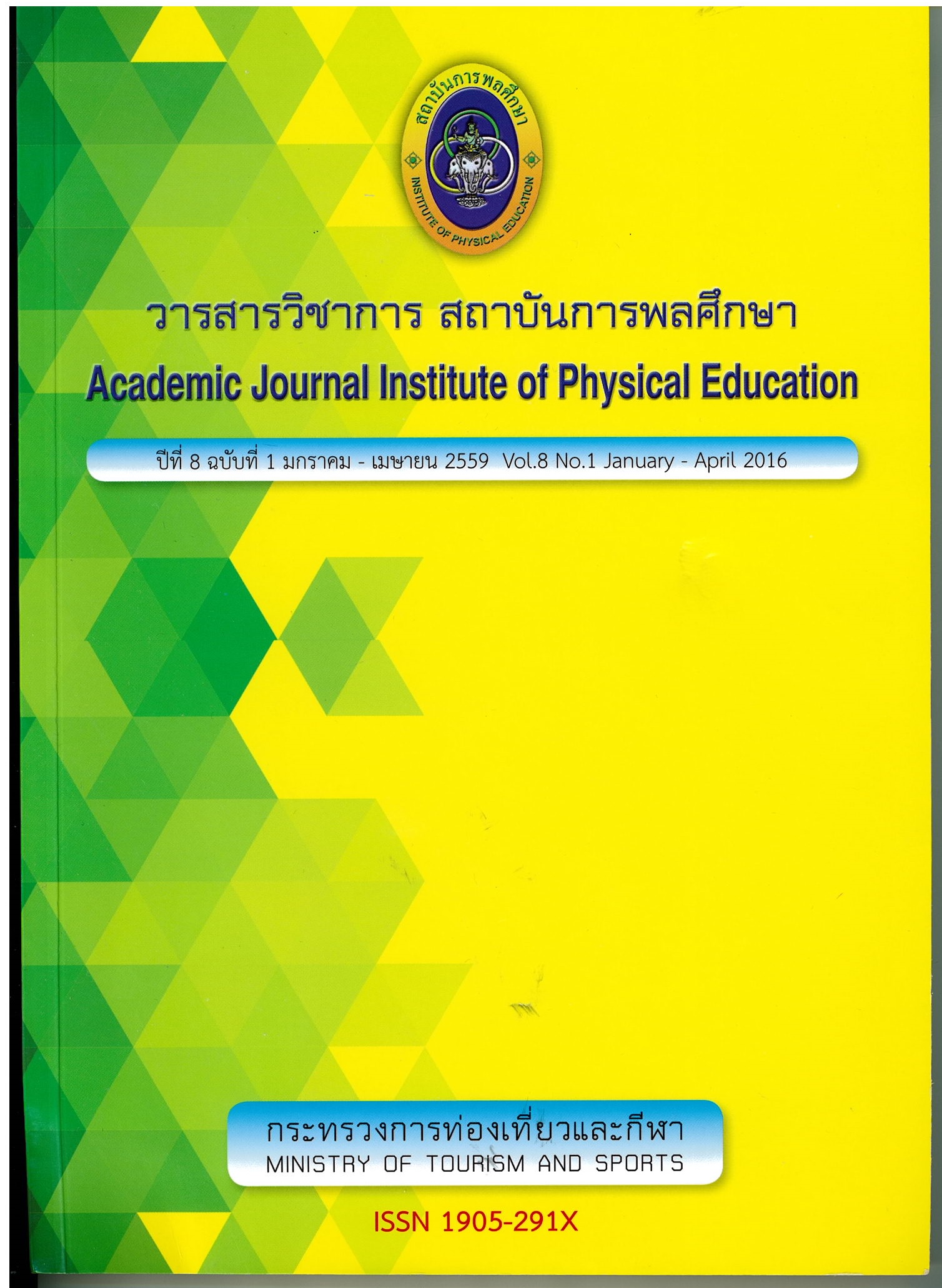ภาวะโภชนาการของนักกีฬาแบดมินตันชายทีมชาติไทย
Main Article Content
บทคัดย่อ
จุดประสงค์ของการศึกษาครั้งนี้เพื่อประเมินภาวะโภชนาการในนักกีฬาแบดมินตันชายทีมชาติไทย จํานวน 16 คน ทําการประเมินภาวะโภชนาการโดยการซักประวัติการบริโภคอาหารใน 3 วัน วัดสัดส่วน ร่างกาย และ ตรวจประเมินผลทางโลหิตวิทยาและชีวเคมี ผลการศึกษาพบว่า นักกีฬาแบดมินตันชาย มีน้ําหนักตัวเฉลี่ย 73+13 กิโลกรัม ส่วนสูง 177+5 เซนติเมตร เปอร์เซ็นต์ไขมันในร่างกาย 11.53+4.36% ได้รับพลังงานจากอาหารเฉลี่ย 2601+512 กิโลแคลอรีต่อวัน โปรตีน 1.64+0.43 กรัม ต่อน้ําหนักตัว 1 กิโลกรัม ต่อวัน ได้รับไขมัน 31.4+5.8 % ของพลังงานที่ได้รับ ปริมาณพลังงานและคาร์โบไฮเดรตที่ได้รับ ต่ํากว่าข้อแนะนําที่นักกีฬาควรได้รับและพบว่าปริมาณวิตามินซี และแคลเซียม ได้รับต่ํากว่าข้อกําหนด สารอาหารอ้างอิงที่ควรได้รับประจําวัน แต่ปริมาณวิตามินบีได้รับพอเพียง ได้ทําการประเมิน ครีเอทีนไคเนส ซึ่งเป็นตัวบ่งชี้ถึงการสลายตัวของกล้ามเนื้อ ผลปรากฏว่าค่าครีเอทีนไคเนส สูงกว่าค่าปกติ ถึง 8796 โดยสรุป นักกีฬาได้รับพลังงาน คาร์โบไฮเดรต วิตามินซี และแคลเซียม ต่ํากว่าข้อกําหนดสารอาหารที่ควรได้รับ ประจําวัน ซึ่งอาจส่งผลกระทบต่อสมรรถภาพทางกายของนักกีฬาได้
Article Details

This work is licensed under a Creative Commons Attribution-NonCommercial-NoDerivatives 4.0 International License.
บทความที่ได้รับการตีพิมพ์เป็นลิขสิทธิ์ของวารสารวิชาการ มหาวิทยาลัยการกีฬาแห่งชาติ ข้อความที่ปรากฏในบทความแต่ละเรื่องในวารสารวิชาการเล่มนี้ เป็นความคิดเห็นส่วนตัวของผู้เขียนแต่ละท่านไม่เกี่ยวข้องกับวารสารวิชาการมหาวิทยาลัยการกีฬาแห่งชาติ แต่อย่างใด ความรับผิดชอบองค์ประกอบทั้งหมดของบทความแต่ละเรื่องเป็นของผู้เขียนแต่ละท่าน หากมีความผิดพลาดใดๆ ผู้เขียนแต่ละท่านจะรับผิดชอบบทความของตนเองแต่ผู้เดียว
References
American College of Sport Medicine. (2000). The American Dietetic Association, and The Dietitians of Canada. Joint position statement: nutrition and athletic performance. Med Sci Sports Exerc, 32, 2130-2145.
Bergeron M.F., Volpe S.L., Gelinas Y. (1998). Cutaneous calcium losses during exercise in the heat regional sweat patch estimation technique. Clin Chem, 44(suppl), A167.
Clark M., Reed D.B., Crouse S.F., Armstrong R.B. (2003). Pre-and post-season dietary intake, body composition and performance indices of NCAA division 1 female soccer players. Int J Sport Nutr Exerc Metab, 13, 303-319.
Coelho D.B., Morandi R.F., de Melo M.A. et al. (2011). Creatine kinase kinetics in professional soccer players during a competitive season. Rev Bras Cineantropom Desempenho Hum, 13(3), 189-194.
Hunkin S.L., Fahrner B., Gastin P.B. (2014). Creatine kinase and its relationship with match performance in elite Australian Rules football. J Sci Med in Sport, 17, 332-336.
Jones B.H., Thacker S.B., Gilchrist J., Kimsey JrC.D., Sosin D.M. (2002). Prevention of lower extremity stress fractures in athletes and soldiers: a systemic review. Epidemiol Rev, 24, 288-347.
Knapik J., Montain S.J., McGraw S., Grier T., Ely M., Jones B.H. (2012). Stress fracture risk factors in basic combat training. Int J Sports Med, 33, 940-946.
Lambert E.V., Goedecke J.H. (2003). The role of dietary macronutrients in optimizing endurance performance. Curr Sports Med Rep, 2, 194-201.
Lappe J., Cullen D., Haynatzki G., Recker R., Ahlf R., Thompson K. (2008). Calcium and vitamin D supplementation decreases incidence of stress fractures in female navy recruits. J Bone Miner Res, 23, 741-749.
Manrique D.C., Gonzalez - Badillo J.J. (2003). Analysis of the characteristic of competitive badminton. Br J Sport Med, 37, 62-66.
McLellan C.P., Lovell D.L., Gass G.C. (2011). Biochemical and endocrine response to impact and collision during elite rugby league match play. J Strength Cond Res, 25(6), 1553-1562.
Mougios V. (2007). Reference intervals for serum creatine kinase in athletes. Br J Sports Med, 41(10), 674-678.
Papadopoulou S.K., Papadopoulou S.D., Gallos G.K. (2002). Macro- and micro- nutrient intake of adolescent Greek female volleyball players. Int J Sport Nutr and Exer Met, 12, 73-80.
Peternelj T.T., Coombes J.S. (2011). Antioxidant supplementation during exercise training: beneficial or detrimental? Sports Med, 41, 1043-1070.
Schutz Y., Kyle U.U.G., Pichard C. (2002). Fat free mass index and fat mass index pein Caucasian age 18-98 y. Int J Obes, 26, 953-960.
Yang Y. (2007). Application of serum CK and BUN determination in monitoring precompetition training of badminton athletes. J Huazhong Univ Sci Technolog Med Sci, 27(1), 114-116.
Young W.B., Hepner J., Robbins D.W. (2012). Movement demands in Australian rules football as indicators of muscle damage. J Strength Cond Res, 26(2), 492-496.

